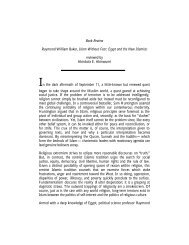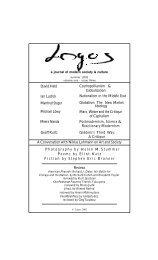Michael J. Thompson Stephen Eric Bronner Wadood Hamad - Logos
Michael J. Thompson Stephen Eric Bronner Wadood Hamad - Logos
Michael J. Thompson Stephen Eric Bronner Wadood Hamad - Logos
You also want an ePaper? Increase the reach of your titles
YUMPU automatically turns print PDFs into web optimized ePapers that Google loves.
Ali Hossaini<br />
it telescopes backward into earlier modalities based in painting, drawing,<br />
cartography and geometry. Media scholars have hinted at this history, but<br />
engineers have written it, and it remains inscribed in generations of tools.<br />
Photography is paradigmatic act of representation, one which blankets the<br />
environment with information. The expression of photographic technology<br />
has followed a path set in the formative days of civilization, and, ironically, its<br />
purpose is clearest in its earliest forms.<br />
Like most machines, cameras automated processes previously done by hand.<br />
The tools of Renaissance painters are obvious forebears to the camera which<br />
makes photography closely related to classical modes of representation like<br />
architecture and mapping. If we trace these practices—perspectival painting,<br />
architecture and cartography—to their collective origin, we arrive at the<br />
archaic civilization of Sumer and the technology of land surveying, or applied<br />
geometry. Surveying occupies a privileged place in the history of photography<br />
and, more generally, of technical drawing. It inspired theoretic geometry,<br />
which in turn spawned optics, astronomy and cartography, the first sciences.<br />
I will collectively refer to these geometric disciplines as technologies of<br />
perception. Succeeding civilizations around the Mediterranean and Europe<br />
have adopted these perceptual practices, and a direct line of transmission<br />
links Sumerian land surveying to present-day photography and electronic<br />
media.<br />
Within this article, I will describe some of the connections between archaic<br />
surveying and modern technology. An important premise of my discussion<br />
lies in the nature of automation or, more precisely, the definition of the<br />
machine. I mentioned above that preoccupation with cameras can lead to<br />
misunderstandings about photography. The photographic camera is a<br />
machine for taking pictures, and it thus seems different in kind from any<br />
other apparatus, even the camera obscura, which still requires an artist to<br />
draw the image. But since a photograph is simply information—the<br />
information specific to a visual display—we need to question whether<br />
cameras are necessary to produce a photographic “thing,” that is, an optically<br />
correct image. This is clearly not the case. Renaissance painters and their<br />
successors devised accurate methods for producing optically correct images,<br />
and their work conditioned the emergence of the camera obscura and<br />
photographic machinery.<br />
I submit that the work of perspectival artists—a group that ranges from<br />
Donatello to the photorealists—lies between intuition and automation. In<br />
<strong>Logos</strong> 2.3 – Summer 2003




